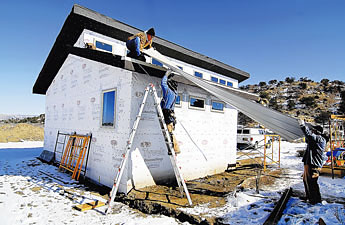|
A Greener Gallup
Guest home built to be environmentally friendly

Robert Chavez and Chris Chavez hand a section of metal roofing up
to Jayson Tom on Wednesday as they work on an energy-efficient house
near the University of New Mexico-Gallup. The 872-square-foot home
will feature energy-saving items such as radiant heat sub-floors,
south-facing windows for passive solar heating and a gray water
and rain water storage system for irrigating plants. [Photo by Jeffery
Jones/Independent]
By Zsombor Peter
Staff Writer
|

The small box on the left serves as the hot water heater and
the furnace for the new energy efficient home being built
by Chris Chavez in Gallup. The small unit heats water on demand,
rather than constantly heating a large tank like a traditional
hot water heater, and the hot water is also used for the radiant
heat system in the floor of the home. [Photo by Jeffery Jones/Independent]
|
GALLUP — There's nothing especially unusual looking
about the guest house going up behind 1825 Milda Ave., nothing except
maybe the sharp slant of the split metal roof. Tucked away at the
end of a winding road less than a mile southeast of the University
of New Mexico's Gallup campus, it should fit right in with the rest
of the neighborhood once stuccoed to meet local zoning standards.
But a look inside, even with a month's worth of work to do, reveals
a house that's anything but typical for Gallup. When finished, it
might just end up being the "greenest" house in town.
When the Burgess' set out to build a guest house behind their home,
they knew they wanted something a little different. As the owners
of a wellness business, helping to bring "healthy water, air
and nutritionals" into people's homes, they were concerned
with more than just the economic costs of the project.
"We're very committed to not impacting the Earth any more than
we have to," said Pam Burgess, "so going green worked
well with those goals."
But finding the right people for the job wasn't easy. Burgess figures
she must have approached just about every builder in town until
a UNM-Gallup student finally referred her to Chris Chavez, an instructor
at the branch. Chavez and wife Keegan Mackenzie opened a design
firm here, Shelter + Design, three years ago.
Mackenzie, a certified architect, designed the guest house. Chavez,
a private contractor, is building it. They started laying the foundation
in early November.
"What we're trying to do is 'low impact,' " Chavez said,
"low impact to the environment, low impact to the site, low
impact on materials."
To best appreciate what he's talking about, it actually helps that
Chavez and his crew aren't finished yet. It's a chance to see the
"green" guts of the house before it's lost beneath a conventional
skin.
When The Independent showed up on site one cold morning, Chavez
was busy hammering a long plastic tube into a coiling recess in
the floor panels. While most homes rely on forced air for heating,
he explained, the "radiant floor" will use hot water pumped
through the tubes in a series of four loops. Because the heat comes
from the floor, it will warm the house as it rises.
"Nobody's really doing this in town," he said.
And that's just the floor. They're using "structural insulated
panels" for the walls.
From the side, each panel looks like a Styrofoam sandwich: two plywood
boards with a piece of foam about five inches thick in the middle.
Because the foam runs throughout the length and width of each panel,
there's no wood to transmit cold from the outer board to the inside,
Chavez said, as in a typical studded frame house.
The argon gas sealed in between the panels of the ample windows
also helps keep the cold out. A "gray water system," meanwhile,
collects bath, laundry and rain water for irrigation. They've also
put the roof to work, using material that reflects 20 percent less
sunlight back into the atmosphere than most. They've even built
the roof in an ideal position for a photo-voltaic cell, if the Burgess'
ever chose to add one.
Yet for all its novelties, this guest house has actually proven
easier to build than most.
"If it was the three of us, it would probably take us a week,
a week-and-a-half, to frame," Chavez said.
Working with the foam-filled panels, they had the walls and roof
up in four days. Ordered to exact specifications from the manufacturer,
the panels fit together like giant pieces in a house-size puzzle.
All that innovation will cost you, however.
"It runs about 10 percent more on materials, but my labor costs
get cut down one third to two thirds," Chavez said, depending
on the size of the project.
The Burgess' also expect to come out on top eventually thanks to
what they'll save on utilities. If they can get the house Energy
Star certified by the federal government, it will be at least 50
percent more energy efficient than normal.
"Over the long run it's definitely going to save money,"
Burgess said.
But because it's all so new combining the various "green"
and "low impact" components into a complimentary whole
no one knows exactly how much.
"This is sort of an experiment," Chavez said. "It's
new stuff for all of us."
In any case, it's about more than saving money, he added: "It's
the fact that you feel you're doing something good for the environment."
|
Thursday
January 18, 2007
Selected
Stories:
UNM-G:
Classes are full, enrollment down
Decision
on Tsosie still out; Navajo Supreme Court to rule on senator's status
as a delegate
Ortega:
Commission will end duties
A Greener
Gallup; Guest home built to be environmentally friendly
Deaths
|



